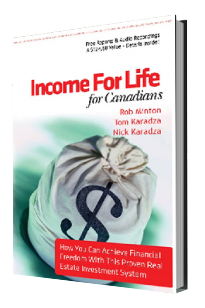Real Estate Investing Websites
There are all kinds of real estate investing websites with great information on strategies for investing in today's market. We thought we'd summarize lessons from history to help you find your way...
Real Estate Investing Websites:
Observations & Strategies for Investing In Today’s Real Estate Market
It’s probably fair to say that as I’m writing this and you’re reading it, there’s a debate raging on real estate investing websites, about the state of the economy and more specifically the state of the real estate market in Canada.
It seems everyone, from Bay Street to your next door neighbour, has an opinion they want to shower you with.
Unfortunately it’s difficult to profit from opinions.
So instead of listening to random opinions on other real estate investing websites, let’s search for lessons from history that we can use to our advantage in today’s real estate market.
Often we look back several decades for experiences that we can learn from, however, we’re in a very unique position where we can learn from very recent experiences of investors in the U.S. and apply them to our own current environment.
Real Estate Investment Types
For example, in the spring of 2007, Nick and I were in a real estate mastermind meeting in Orlando with a small group of active real estate investors.
It was during those meetings that we first detected something wrong with the U.S. market. As on several real estate investing websites, the discussions turned to how lending began to freeze up and investors who were buying two properties a month, every month, were now locked out of the market. No warning. The banks just stopped lending to them.
A raging discussion broke out between the U.S. based investors about possible reasons for this, and about the “asset classes” or “property types” that would best whether any upcoming economic storm.
Some believed that the never ending demand for “McMansions” were the safest bet because once a family had a taste of 3,000 square feet full of granite and exotic hard woods, they would never go back to anything less. And therefore they would keep “flipping” that category of property.
Others vowed their starter home rental properties were the foundation of their portfolio and would never fail them. Others believed apartment buildings would never be empty. Finally, still others argued that malls and medical buildings were the safest places to stash their cash.
Almost everyone agreed that most vacation property would have some challenging times ahead.
Similar types of discussions were going on at the time in the news and on real estate investing websites.
Who Was Right?
So, several years have now passed since that time, who was right?
We’ve had some time to catch up with many of these investors over the last several months.
From two brothers in North Florida, to another investor in Fort Lauderdale, another in St. Louis, to another in Chicago and several in Ohio. What have we found?
Affordable starter homes and good apartment buildings have weathered the U.S. economic storm the best. Although some have lost value, they have continued to cash flow very nicely.
We conclude, after watching each of these markets and studying real estate investing websites, that there are two reasons for this: affordability and demand.
Although things got tough in many markets people still needed a place to live and we can assume from these observations that many chose to either go back to renting an apartment, or to downsize and rent a starter home.
Now, unfortunately, our little survey is in no way scientific, and can’t be used as the basis of a Harvard Case Study. But, we are getting these results directly from real estate investors who we know, not just the opinions found on real estate investing websites.
So take this information and make your own conclusions— which is always the best approach.
These findings, to us, are interesting nonetheless.
We also found that the investors that seem to have had the smoothest ride (meaning, most profit and cash flow) over the last several years had property in communities with good population and diverse employment. A good example of this is a friend in Chicago. Throughout the last few years they have seen very little change in property prices and good demand for his rentals. Others, in low density areas of Florida, haven’t faired as well.
Bottom Line
If you take a look at any real estate investing websites you know there is always a demand for good places to live.
There is more demand in the starter home category than any other home category. You can either offer rental properties to this demand or rental apartments, your choice, but that’s where demand is strongest.
What else can we take from this? Although property type is important, the fundamentals still matter.
Buy in communities that have good population growth, diverse employment and developing transportation and infrastructure improvements.
These increase the demand for property in the area and will increase the demand for your property as well. Let the ‘rising tide” of a community work in your favour.
What else? What other points are real estate investing websites covering? What other trends can we look at that may enhance our choices and guide our decisions.
What about demographics?
There’s been a lot of press and talk on real estate investing websites around the aging baby boom generation that’s approaching retirement right about now. Will these people be looking for larger homes with huge stair cases or smaller, single storey homes?
Likely, the latter.
Will some move into apartments and condos? Of course.
If we know this, then a basket of single storey family homes and some apartment buildings, may be a good mix of property.
Not only are they the safest in turbulent economic conditions, but they also fit with the current demographic changes in population.
A win-win.
Which Properties Faired The Worst?
McMansions, commercial strip malls, small office buildings, and low-end vacation property.
Do you want to be flipping McMansions in communities where people can’t sell 3,000 square foot homes for $220,000? We have direct knowledge of investors trying this in Ohio and Tennessee. Not fun and not profitable.
What about commercial strip malls and small office buildings, in small and medium sized communities (population under 1,000,000)? Losers as well. Financing is difficult, so sellers are scarce, and as businesses close during economic upheavals, vacancies increase.
So Where’s The Opportunity?
In about 24 months, as the credit market comes out of this freeze, there may be a great opportunity to pick up some of these commercial buildings for bargain basement prices. These properties will likely have been sitting idle for years, which now have motivated sellers willing to do some creative financing to unload them.
It’s still too early today to jump on these because we believe the U.S. is in the eye of the mortgage storm right now.
There may be some interesting opportunities in these asset classes headed our way shortly. It's always a good idea to keep up with announcements in the news and join discussions on real estate investing websites.
What About Interest Rates?
If we look at how the best U.S. investors have handled their cash flow on real estate investing websites, here’s what we can learn. Many of them locked in their rates over the last 12 months at historic lows.
They believe that variable rates may continue to stay low, but decided to fix their costs for the next several years, to protect against any drastic changes in U.S. interest rate policy.
With the U.S. Treasury likely required to raise billions of dollars in cash to fund increasing deficits, this may not be such a bad idea. At some point they will likely have to increase rates to attract Treasury buyers. This will increase the interest rates on mortgages as bond yields increase.
(Aside: Our rates in Canada are even lower than most of those available to investors in the U.S. so we’re still sitting on many variable rate mortgage products but are watching closely).
Many of our U.S. counterparts refinanced properties where and when they could. They extracted cash and “parked it”. They’re now sitting on it, waiting for the right opportunity. Others withdrew money from any credit lines they had and stashed the cash in chequing accounts.
This was done as a precaution against banks lowering their credit limits.
They wanted to act before the banks did and decided that access to cash is critical to their real estate business. Theses investors chalked up the interest payments on these credit lines as the “cost of doing business”.

“The Three C’s”
This brings us to the three C’s. Both Nick and I have noticed that investors who continue to make big money in the U.S. have had access to: Cash, Cash Flow and Credit.
In fact, most real estate investing websites will tell you the same thing.
So
the ones who refinanced their properties and tapped into credit lines,
are the same ones who have been taking advantage of opportunities as
they arise.
They have paid back any loans with high rates but
interestingly, loans with extremely low rates have not been paid back.
Instead, cash has been preserved and left in bank accounts readily
available, should it be needed.
These investors have also been
maximizing their cash flow by being unscrupulous when it comes to
cutting expenses. All necessary expenses are negotiated down as much as
possible, and all optional expenses are cut. This is something we should
all be doing, but in good times it’s easy to get lazy.
Expenses that have not been reduced: insurance and asset protection.
All
assets have the proper insurance on them (this means that things like
student rentals actually have student rental insurance in place, and not
regular insurance even though it costs twice as much). And corporate
structures have been set up to maximize asset protection when
appropriate.
Also, active credit monitoring is common practice, which is a common recommendation across real estate investing websites.
A
sophisticated investor monitors his/her credit in any environment,
however, in environments where lending gets tight, banks will only hand
over cash to investors with the best credit.
Monitoring credit scores is of extreme importance and it should be something you watch closely.
Both
Equifax.ca and Transunion.ca have credit monitoring available for
approximately $10 per month. They will email you an alert whenever
someone pulls your credit.
What Can We Learn From This?
Cash,
Cash Flow and Credit are the key ingredients in any economic
environment but play an even more important role if lending becomes very
tight.
Those with access to cash and good credit will be able to profit from the very best opportunities.
And, as always, positive cash flow is critical to longevity in this business.
Three Unique Canadian Observations
As
Canadians there are three main advantages that became apparent to both,
Nick and I, as we chatted with our U.S. investor buddies. And each of
them seemed to have some contribution towards a more stable real estate
market in Canada.
First, Health Care.
Some counties in the U.S. list unexpected health care payments as the number one reason for mortgage defaults.
We
so often forget that unique advantage we have in Canada. Our stable
real estate market is partially due to the health care system in Canada.
Your
tenants can get the majority of their health care needs taken care of
for free in Canada and although there are obviously cases where
additional money must be spent, overall, this is a very unique Canadian
advantage.
It was amazing to us as we chatted with U.S.
investors and did some research on real estate investing websites, how
often “health care costs” came up as a reason for missed rent and/or
missed mortgage payments.
Second, Higher Education.
The cost of tuition in the U.S. has risen drastically over the last fifty years.
It’s
not uncommon for U.S. students to come out of college owing massive
amounts of money for their education. These young adults are carrying
huge debt loads from the moment they enter the work force.
Higher
debt loads for first time home buyers only means there are more
opportunities for mortgage defaults. Compared to the U.S. our higher
education is much more affordable.
Third, Tax Write-Offs.
The
interest on Canadian mortgages is not tax deductible (for primary
places of residence). For some reason, this fact, seems to dampen any
sudden need for Canadians to refinance and spend money needlessly.
And perhaps that’s why 80% of Canadian mortgage holders have 20% equity in their homes or more. (Source: CAAMP, November 2009)
In Summary
Canada
has enough unique differences from the U.S. to maintain a very stable
and healthy real estate market. However, we are not completely naïve,
and realize that we must prepare for anything and everything.
Starter
homes and apartment rentals in areas with growing population, income
and transportation continue to be our favourite choices of property.
Perhaps
even a hospital or university near by would further enhance our choice
(government jobs and endless amounts of students are always good
ingredients to throw into the mix).
There may be some great
opportunities in U.S. commercial and vacation property asset categories
as we transition through the next wave of the mortgage storm.
Finally,
Cash, Cash Flow and Credit are the three keys to success. Access to
cash will allow you to whether anything and jump on opportunities as
they arise.
And from studying the extremely wealthy (Warren Buffet, Bill Gates etc.) people we’ve realized having cash reserves is a common trait amongst them. In a recent interview Buffet mentioned, in passing, that cash reserves allow you to control your future. We believe him. Remember the three C’s!
Some Cool Free Stuff...
Step 1:
|
Grab a free digital copy of our real estate investing book, Income For Life For Canadians, right here. This book has been downloaded over 22,597 times and has helped hundreds of investors kick-start their investing with simple and straight forward strategies that you can implement right here in Canada. |
 |
|
You'll also receive our weekly [Your Life. Your Terms.] email newsletter with the latest investing updates and videos. |
Step 2:
|
Free Weekly Investing Videos & Articles: Get the latest updates and join the over 10,000 other Canadians enjoying the weekly [Your Life. Your Terms.] email newsletter. The email is sent out each Thursday. And as a little bonus we'll give a FREE digital copy of the book, Income For Life For Canadians, too! |
Your Life. Your Terms.
Step 3:
|
Free LIVE Investing Class: Do you live in the Greater Toronto or Golden Horseshoe Area? Come out to our next introductory "Investing in Nice Homes in Nice Areas" Real Estate Class. |
 |
|
It's 90-minutes and you'll learn a ton - promise!Thousands of investors have now joined us for this class and the feedback has always been amazing. |



